Meme coins are a unique and often humorous phenomenon in the cryptocurrency world. Unlike their more serious counterparts, meme coins don’t necessarily have any groundbreaking technology or real-world use cases. Instead, their value is often driven by hype, community support, and, of course, the power of memes.
History of Meme Coin
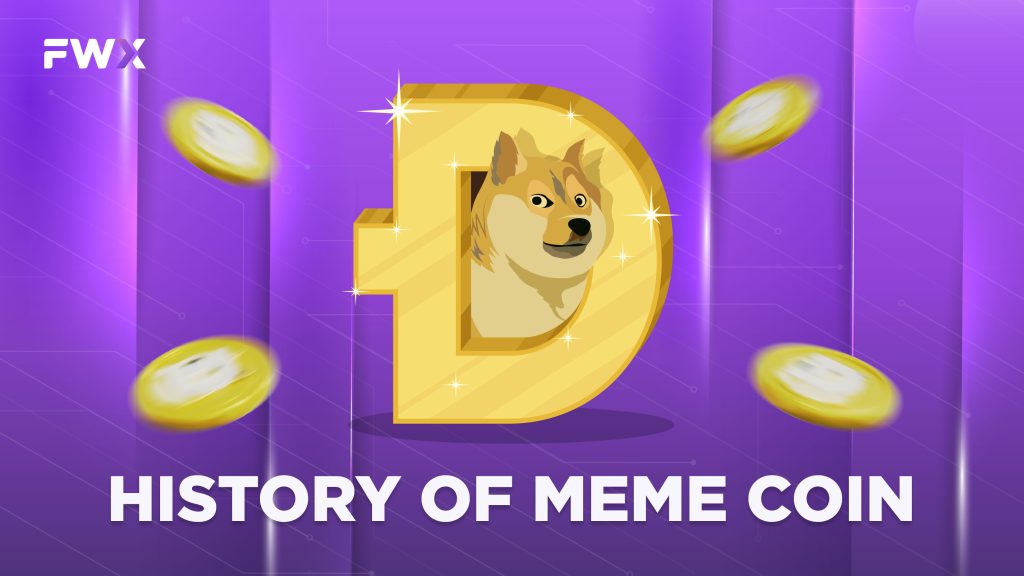
Meme coins, the quirky and often hilarious side of crypto, have a surprisingly rich history rooted in internet culture and a dash of technological ingenuity. Buckle up as we delve into the timeline of these viral sensations, from their humble beginnings to their current meteoric rise.
2013: The Birth of Doge
The year 2013 marks the dawn of the meme coin era. Billy Markus and Jackson Palmer, two software engineers with a penchant for humor, unleashed Dogecoin (DOGE) upon the world. Inspired by the popular “Doge” meme featuring a Shiba Inu dog and broken English captions, Dogecoin was initially intended as a satirical jab at the rampant speculation in the early cryptocurrency scene.
2017-2021: The Meme Coin Explosion
Dogecoin’s success paved the way for a Cambrian explosion of meme coins in the following years. Inspired by everything from grumpy cats and Pepe the Frog to Elon Musk’s tweets, a plethora of meme coins flooded the market, each vying for attention with their own unique brand of humor and absurdity.
2022-Present: The Meme Coin Rollercoaster
The rise of meme coins has been accompanied by a rollercoaster of emotions. Their prices often experience wild swings, driven by hype, community sentiment, and the unpredictable whims of social media. While some meme coins have achieved impressive gains, others have crashed and burned, leaving investors with significant losses.
Despite the inherent risks, meme coins remain a popular phenomenon, attracting both enthusiastic supporters and cautious observers. Their ability to tap into the collective humor and online engagement of the internet community ensures that they will likely be a part of the crypto landscape for years to come.
What are Meme Coins?
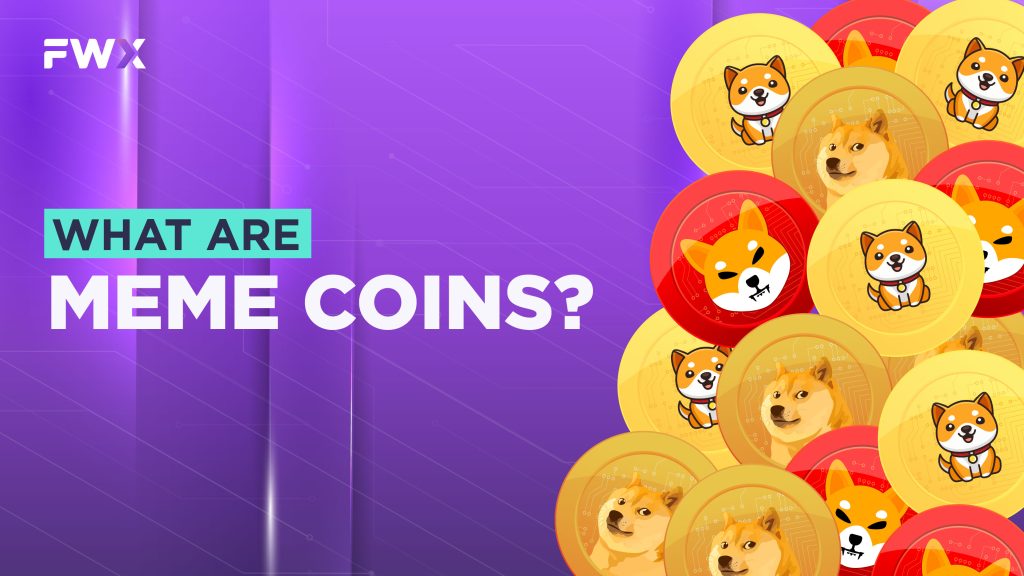
A meme coin is a type of cryptocurrency that derives its name and popularity from internet memes and social media trends. Unlike traditional cryptocurrencies such as Bitcoin or Ethereum, meme coins often lack a clear use case, technical innovation, or underlying technology. Instead, their value is primarily driven by online communities, social media influencers, and the virality of memes.
They are often created quickly and easily through tokenization on existing blockchain platforms, with Ethereum being a popular choice for their creation. These coins may have humorous or satirical origins, and their success is often fueled by online communities that promote and share them through memes and online discussions.
The value of meme coins can be highly volatile, and their prices may be influenced by factors such as social media trends, celebrity endorsements, and community sentiment rather than fundamental analysis or technological advancements. Investors need to approach meme coins with caution, as their value can be subject to rapid and unpredictable changes based on internet culture and online dynamics.
How Do Meme Coins Work?
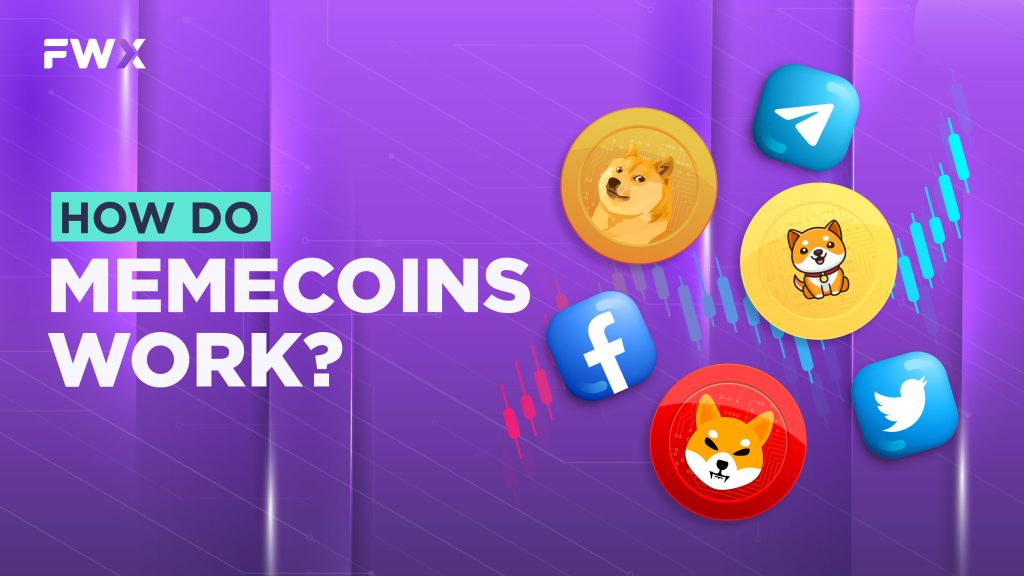
Meme coins operate on blockchain technology, similar to other cryptocurrencies, but their mechanics and value drivers are often distinct. Here’s an overview of how meme coins typically work:
- Creation and Tokenization:
- Meme coins are usually created on existing blockchain platforms, such as Ethereum, Binance Smart Chain, Avalanche or others that support token creation.
- Developers can generate these tokens with relative ease, often requiring minimal technical expertise. This process is known as tokenization.
- Community and Social Media Promotion:
- The success of meme coins is heavily reliant on online communities and social media platforms. These communities actively promote the coin through memes, discussions, and online forums.
- Social media influencers and celebrities may play a significant role in promoting them, contributing to their visibility and popularity.
- Speculative Trading:
- They are often traded on cryptocurrency exchanges. Investors buy and sell these coins speculatively, hoping to profit from price fluctuations.
- The value of them can be highly volatile and may not necessarily be tied to traditional market fundamentals.
- Tokenomics and Incentive Mechanisms:
- Some meme coins incorporate unique tokenomics to attract and retain investors. For example, token burns, redistribution mechanisms, or penalties for selling (as seen in SafeMoon) are designed to create incentives for holding the coin.
- Community Governance:
- In some cases, meme coins involve their community in decision-making processes through governance mechanisms. Token holders may have voting rights on certain protocol changes or initiatives.
- Liquidity Pools and Decentralized Finance (DeFi):
- Meme coins often participate in decentralized finance (DeFi) protocols. Liquidity pools, yield farming, and other DeFi mechanisms may be utilized to enhance the functionality and attractiveness of the meme coin.
- Viral Marketing and Hype:
- Meme coins thrive on viral marketing and hype. The creation of memes and online content contributes to the visibility and popularity of the coin.
- The “meme” aspect of these coins plays a crucial role in creating a sense of community and excitement, attracting new participants.
- Risks and Caution:
- Investors should approach meme coins with caution due to their speculative nature. The lack of a clear use case, unproven technologies, and reliance on online trends make them susceptible to rapid and unpredictable price movements.
Meme Coin vs Cryptocurrency, What are the Differences?
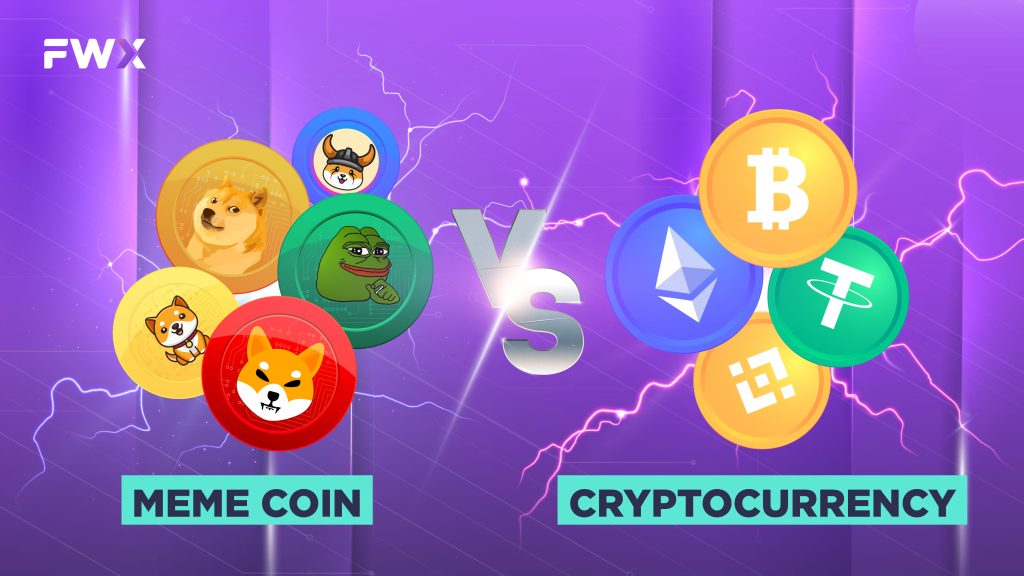
The world of cryptocurrencies is vast and diverse, and while both meme coins and “regular” cryptocurrencies fall under the same umbrella, they present distinct differences in their origins, value drivers, and overall approach. Here’s a breakdown:
Origin:
- Meme Coins: Born from internet memes and pop culture references, often aiming for humor and lightheartedness.
- Cryptocurrencies: Driven by real-world applications, technological advancements, and solving practical problems.
Value Driver:
- Meme Coins: Fueled by community hype, social media buzz, and speculation. Their value can rise and fall rapidly based on online trends and influencer endorsements.
- Cryptocurrencies: Derive value from their underlying technology, utility, and real-world use cases. Their price can be influenced by market forces, adoption rate, and underlying developments.
Volatility:
- Meme Coins: Highly volatile, prone to dramatic price swings due to their dependence on sentiment and speculation.
- Cryptocurrencies: Vary in volatility, but generally less volatile than them due to their stronger underlying fundamentals.
Technology:
- Meme Coins: Often built on existing blockchain networks, focusing on simplicity and ease of use.
- Cryptocurrencies: Can be innovative and complex, with custom blockchains and unique features designed for specific purposes.
Use Cases:
- Meme Coins: Primarily used for speculation and trading, with limited real-world applications. Some offer staking rewards or community access.
- Cryptocurrencies: Can facilitate payments, power decentralized applications (dApps), and enable secure transactions across various industries.
Overall Approach:
- Meme Coins: Playful, community-driven, and often focused on fun and entertainment.
- Cryptocurrencies: Serious, focused on solving real-world problems and driving technological advancements.
What are meme coins used for?
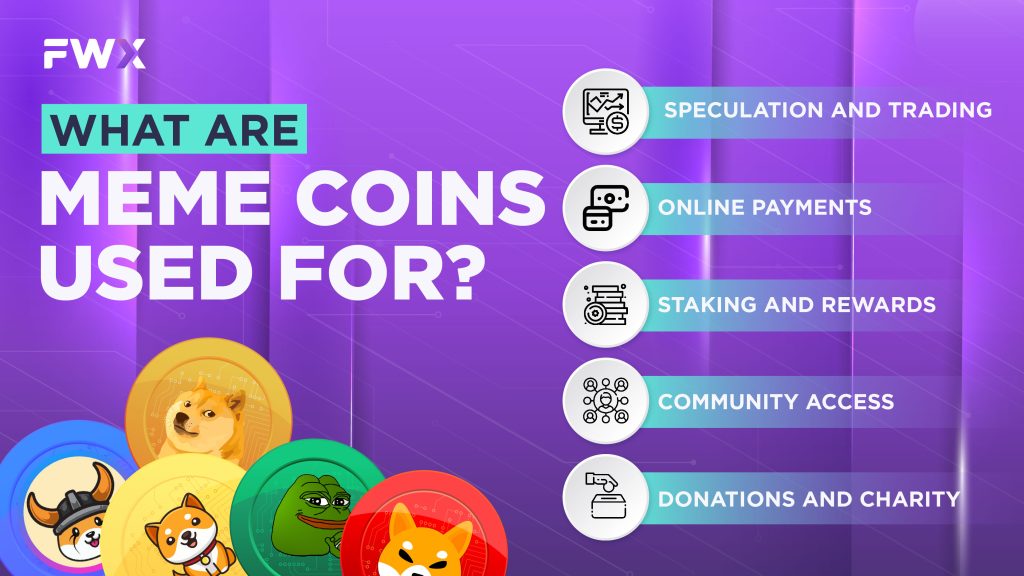
Meme coins can be used for a variety of things, though their primary purpose is often speculation and community engagement. However, depending on the specific project, they can also offer some limited real-world applications:
1. Speculation and Trading:
This is the most common use case for them. Their volatile nature and dependence on community sentiment make them attractive to traders seeking quick gains. However, the high risk of rapid price swings should be considered.
2. Online Payments:
Some meme coins are attempting to integrate with payment platforms, allowing users to make online purchases or send and receive money. However, adoption is still limited and primarily focused on niche communities.
3. Staking and Rewards:
Certain meme coin projects offer staking options, where holders can lock their tokens in a pool and earn rewards in exchange for supporting the network. This can be a way to generate passive income, but the rewards might not be significant.
4. Community Access:
Some meme coin projects offer exclusive benefits to holders, such as access to online communities, voting rights on project decisions, or early access to new features. This can foster a sense of belonging and engagement within the community.
5. Donations and Charity:
Meme coins can be used for charitable donations. Some projects have partnered with charities or dedicated a portion of their token supply to good causes.
It’s important to remember that the use cases for meme coins are generally limited compared to traditional cryptocurrencies. They often lack inherent utility or real-world applications, making their value primarily driven by speculation and community sentiment.
Examples of Meme Coins
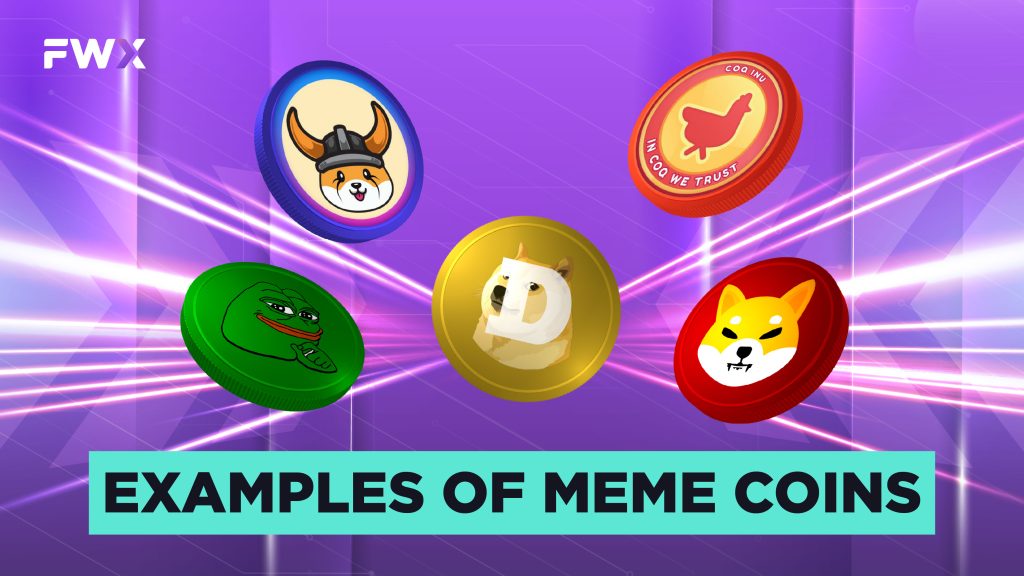
The realm of meme coins is as vibrant and unpredictable While established players like Dogecoin (DOGE) and Shiba Inu (SHIB) reign supreme, new challengers like Coq Inu (COQ) are ruffling feathers and hoping to claim their piece of the pie. Let’s take a closer look at these top contenders:
- Dogecoin (DOGE): The OG meme coin, forever immortalized by the Doge meme and its association with Elon Musk. Its playful Shiba Inu mascot and tongue-in-cheek approach have captured the hearts (and wallets) of millions.
- Shiba Inu (SHIB): The “Dogecoin killer” arrived with a bang, promising to surpass its predecessor with a larger supply and a more ambitious roadmap. Its rabid community and constant developments keep SHIB in the spotlight.
- Floki Inu (FLOKI): Inspired by Elon Musk’s Shiba Inu puppy, Floki Inu leverages the power of community and storytelling to carve its niche. Its focus on blockchain gaming and metaverse integration adds a unique twist to the meme coin game.
- Pepe Coin (PEPE): A blast from the internet’s past, Pepe Coin brings the popular Pepe the Frog meme to the crypto world. Its lightheartedness and community focus might not revolutionize the space, but it offers a fun and familiar entry point for meme enthusiasts.
- Coq Inu (COQ): Now, here’s where things get interesting. Coq Inu, claiming to be the self-proclaimed #1 meme coin on Avalanche. It’s listed on many platforms.
Pros and Cons of Meme Coin
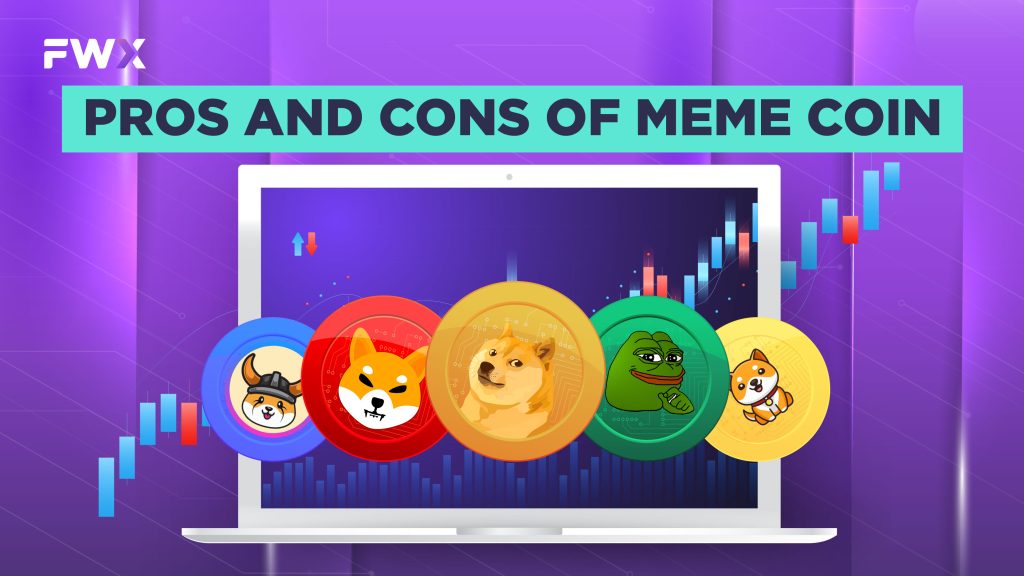
Meme coins, the cheeky underdogs of the crypto world, offer a unique blend of entertainment and potential profit. But before diving into this wacky pool, let’s weigh the pros and cons to ensure you’re making informed decisions:
Pros:
- High entertainment value: Meme coins are often lighthearted and playful, infused with internet humor and pop culture references. Investing can be a fun way to express your online identity and connect with like-minded communities.
- Explosive growth potential: Due to their community-driven nature and hype cycles, they can experience rapid price appreciation, leading to significant gains for early investors. Dogecoin (DOGE), for example, surged over 12,000% in 2021.
- Community support and engagement: Meme coin communities are passionate and active, offering a strong support network and potential for collaboration around shared goals, such as charity initiatives or technological development.
- Low barrier to entry: Meme coins are often priced very low, making them accessible to even the most budget-conscious investor. This allows for participation in the crypto market without risking large sums of money.
Cons:
- Extreme volatility: Meme coin prices are notoriously volatile, susceptible to sharp fluctuations based on hype, social media trends, and even Elon Musk’s tweets. This high risk of substantial losses is a major downside.
- Lack of inherent utility: Unlike many other cryptocurrencies with specific functions or real-world applications, meme coins often lack intrinsic value. Their price mainly relies on speculation and community sentiment.
- Pump-and-dump schemes: The unregulated nature of the crypto market makes them a target for scams and pump-and-dump schemes. Unscrupulous individuals can artificially inflate prices before dumping their holdings, leaving unsuspecting investors with significant losses.
- Regulatory uncertainty: Meme coins face increasing scrutiny from regulatory bodies due to their speculative nature and potential for financial harm. This could lead to stricter regulations and limitations on trading, impacting their future viability.
In conclusion, meme coins add a lighthearted and sometimes chaotic dimension to the world of cryptocurrency. While they lack the serious purpose of established cryptocurrencies, their reliance on humor, community, and internet culture can be surprisingly powerful. Investing in them, however, requires a healthy dose of caution due to their volatility and potential for scams.


